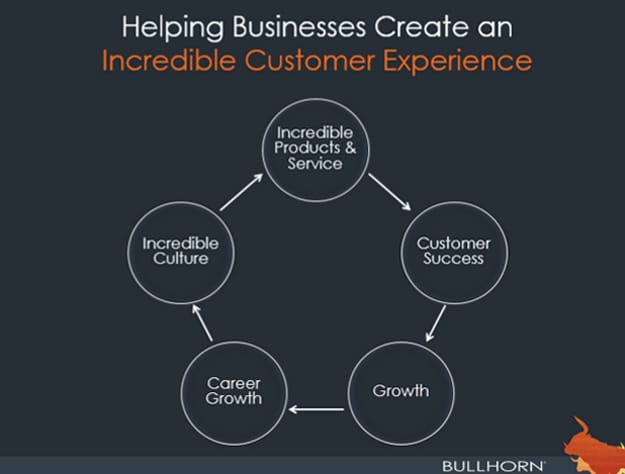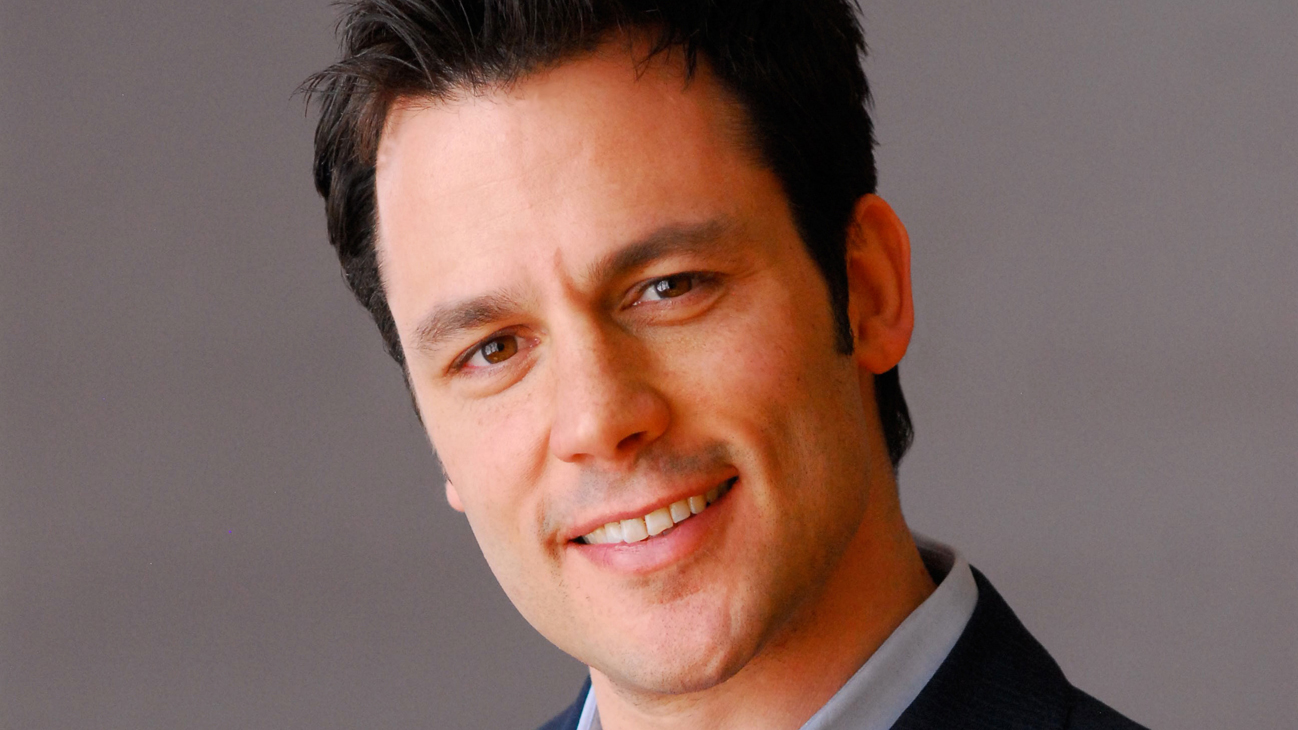Ryan Estis challenges conventional thinking on corporate culture, communication, client acquisition, brand ambassadorship and change. The former chief strategy officer for the marketing division of McCann Erickson, he helps companies, leaders, and sellers more effectively connect to their two most important audiences: employees and customers. Guiding audiences through the realities of the new economy, he blends interaction, energy, and actionable content to transform and elevate your business outcomes. Below, he writes on the importance of the customer experience:
The best brands are known for great customer experiences.
Bullhorn is a company delivering exactly that. Founded by CEO Art Papas in 1999, it has grown into a booming CRM software company with 500 employees and 10,000 customers.
I was fortunate to participate in Bullhorn’s user conference, Engage, last month. In his keynote to kick off the conference, Art shared why he completely changed the company’s mission. I was impressed with the talk and the incredible growth of the company. After the event, I caught up with Art to learn more.
Creating a Customer-Focused Corporate Mission
Until a few years ago, Bullhorn had a pretty generic corporate mission statement — to be No. 1 in the market, to be the No. 1 service provider to their customer set, etc. “Our mission was about goals we wanted to achieve,” Art says. “We were going through hyper growth and achieving our mission, but not necessarily creating the kind of experience for customers we wanted. The faster we grew, the better it was for us, but the worse it was for our customers.”
So Art decided to flip the company’s mission on its head. “I wanted to create something that could last forever. We needed a core purpose.”
He created a new Bullhorn corporate mission statement: to help businesses create an incredible customer experience. In full: “We help businesses achieve extraordinary results by transforming the way people work and interact with customers. We create software that’s both powerful and a pleasure to use and pair it with fantastic customer service.”
That mission has two key elements:
- Create incredible products and services.
- Look for ways to help customers differentiate themselves as beacons in their own industries.
But steering a large company in a new direction isn’t easy. “When I changed the mission, people thought I was crazy,” Art says. “We’re a big company — wasn’t this too touchy-feely?”
How Bullhorn Got Employees on Board
Art and his leadership team changed everything, starting with how they communicated the company’s purpose to employees.
Share the ‘Why’
“The ‘why’ really matters. First, we told people why they should care about customer experience,” Art says.
To explain that, he drew a wheel that shows the effect of delivering an incredible customer experience, and the eventual positive effects that experience has on employees. “It’s a virtuous cycle, and when you draw it out, people see why great customer experience will help them have a great employee experience.”

Get Specific about Expectations
Art created a 60-page deck that he calls “a field guide to being successful at Bullhorn.” The deck includes specific dos and don’ts related to five values: Ownership, Energy, Agility and Speed, Service, and Being Human. Here’s an example:
How to Take Ownership:
- Stay with a problem until it’s resolved, or until someone else tells you they own it.
- Do what you say you’re going to do.
- Deliver high-quality work the first time.
- Manage and reset expectations.
- Earn trust by getting things done and solving problems.
- Admit mistakes quickly.
- Speak up when you see problems and offer solutions.
Things You Won’t Do:
- Redirect your work to others.
- Forget commitments or deadlines.
- Ignore problems or assume someone else is on it.
- Throw shoddy work over the wall to another team.
- Cover up mistakes.
All the employee values are tied to customer results and experiences and employees reference the deck regularly. An example of an employee value: “People hate data entry. It’s our job to figure out clever ways to eliminate it.”
Recognize Employees Who Do Great Work
“I love positive customer feedback — it fuels me,” Art says. “When we were growing quickly, I was getting all kinds of external awards, but those were meaningless compared to getting a call from a customer saying we were doing a great job.”
Art had a lightbulb moment after Bullhorn had started its renewed focus on customer experience. The product team was improving its products, and a few early adopters on the service team were doubling down on the new mission. Several long-time customers sent Art holiday gifts, thanking him for everything Bullhorn had done for their business. “I knew I had to find a way to share that feeling with the rest of the employee base,” he says. “We needed that kind of customer love fueling our organization.”
Thus, he created a team of people to “catch employees doing something right.” That team looks for great work, recognizes those people, and coaches others who need help.
Bullhorn leaders call out employees and highlight examples of great work in company meetings and all-company publications. Every month, an update goes out with a full page of customer quotes about Bullhorn employees. “It’s become part of our culture now,” Art says.
Tie Employee Goals to the Mission
To show employees they were serious about this culture change, Bullhorn leaders reworked the company’s bonus and performance review processes, aligning goals and incentives to the overall mission.
Leaders set company goals for customer satisfaction metrics and customer retention rates, then tied everyone’s bonus to those goals. Managers’ bonuses were also based on their employees’ satisfaction and engagement.
Managers are very important at Bullhorn. “Perks are meaningless. If someone has a bad boss, a ping pong table and free snacks aren’t going to keep them in the job. You have to create an experience for employees that makes them feel like they’re doing something meaningful. People want a sense of purpose.”
Real Results
A year after the changes started, “we were really walking the walk,” Art says. “It’s had a profound effect on the business.”
Customer satisfaction and retention scores went up. Employee retention rates followed. Employee satisfaction scores were the last metric to move — they were flat, but Art was patient. “You have to have a long view and stick to it. It’s very tempting to start an initiative like this and then give up a month in,” he says. “But then, all of a sudden, that last metric kicked in and our employee satisfaction score went from 3.2 to 4.4. You can look on Glassdoor and see our trends improving over time.”
Creating Incredible Customer Experiences at User Conferences
This year, Bullhorn applied the lessons they’d learned internally to their annual user conference. In past years, it was called Bullhorn Live, and it focused on the product. The 2015 event was rebranded around the theme Engage and focused on delivering content to help people do their jobs better, manage people more effectively, grow their businesses, and innovate.
“We used to struggle to get customers to come,” Art says. “People used to say it was good and our team had done a nice job. The difference in feedback this year was stark. People came away saying they’d learned a tremendous amount — and not just about Bullhorn software. We helped our customers come up with their next great idea, and now we get to play a role in helping them achieve it. We doubled the attendance this year, and we already have applications for people who want to speak in 2016.”
What’s Next for Bullhorn?
I asked Art what’s next for Bullhorn. He didn’t hesitate: preserving the culture as the company grows. Bullhorn had 400 employees at the start of 2015. In June they hit 500. “Preserving this culture is what keeps me up at night,” he says. “I have both hands on the wheel, staring straight ahead.” He’s focused on leadership development, and he hired a leadership coach from Korn-Ferry to help Bullhorn train managers and leaders as the company grows.
One thing he’s learned as the leader of a high-growth company is the importance of being in-tune with yourself. “I’ve learned not to ignore things that are bothering me. If something’s bothering you as the leader, it’s bothering everyone else times 10. The times I’ve gotten in trouble are when I’ve thought I couldn’t fix a problem — I’d think, ‘we’re growing too fast. Let’s just get through the next quarter.’ Now I know to pay attention to how I’m feeling about the company and attack problems head-on,” Art says.
“As a leader, your passion and drive for your business are going to be contagious to your employees, so you have to stay in-tune with how you’re feeling and how the company is doing.”
Branding the customer experience is important. If you can’t execute on your customer experience as you grow, customers will notice. World-class brands define their customer experience, create a clear process for executing it, and fuel their organizations with customer feedback and love.

